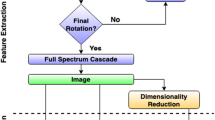Abstract
The paper considers the use of fully connected networks for classifying the states of a rotary machine based on a vibration signal. An experimental stand is proposed. We worked with three different states of the experimental setup. The new approach is to use generative adversarial networks to create artificial data and various architectures of fully connected neural networks. We also tested different combinations of training and validation datasets. As a result, the use of all these methods makes it possible to improve the accuracy of the network by about 6.5%.
The work has been carried out at the Oryol State University named after I.S. Turgenev with the financial support of the Ministry of Science and Higher Education of the Russian Federation within the project “Creation of a digital system for monitoring, diagnosing and predicting the state of technical equipment using artificial intelligence technology based on domestic hardware and software”, Agreement No. 075-11-2021-043 from 25.06.2021.
Access this chapter
Tax calculation will be finalised at checkout
Purchases are for personal use only
Similar content being viewed by others
References
An, J., Ai, P., Liu, D.: Deep domain adaptation model for bearing fault diagnosis with domain alignment and discriminative feature learning. Shock Vibr. 2020, 4676701 (2020). https://doi.org/10.1155/2020/4676701
Belagoune, S., Bali, N., Bakdi, A., Baadji, B., Atif, K.: Deep learning through LSTM classification and regression for transmission line fault detection, diagnosis and location in large-scale multi-machine power systems. Measurement 177, 109330 (2021). https://doi.org/10.1016/J.MEASUREMENT.2021.109330
Brito, L.C., Susto, G.A., Brito, J.N., Duarte, M.A.: An explainable artificial intelligence approach for unsupervised fault detection and diagnosis in rotating machinery. Mech. Syst. Sig. Process. 163, 108105 (2022). https://doi.org/10.1016/J.YMSSP.2021.108105
Dias, A.L., Turcato, A.C., Sestito, G.S., Rocha, M.S., Brandão, D., Nicoletti, R.: A new method for fault detection of rotating machines in motion control applications using profidrive information and support vector machine classifier. J. Dynamic Syst. Meas. Control Trans. ASME 143, 041007 (2021). https://doi.org/10.1115/1.4048784/1088474
Goodfellow, I., et al.: Generative adversarial networks. Commun. ACM 63, 3422622 (2020). https://doi.org/10.1145/3422622
Goodfellow, I.J., et al.: Generative adversarial networks (2014). https://doi.org/10.48550/arxiv.1406.2661
Hartmann, K.G., Schirrmeister, R.T., Ball, T.: EEG-GAN: generative adversarial networks for electroencephalograhic (EEG) brain signals (2018). https://doi.org/10.48550/arxiv.1806.01875
Hazra, D., Byun, Y.C.: SynSigGAN: generative adversarial networks for synthetic biomedical signal generation. Biology 2020 9(12), 441 (2020). https://doi.org/10.3390/BIOLOGY9120441
Kornaeva, E.P., Kornaev, A.V., Kazakov, Y.N., Polyakov, R.N.: Application of artificial neural networks to diagnostics of fluid-film bearing lubrication. IOP Conf. Ser. Mater. Sci. Eng. 734, 012154 (2020). https://doi.org/10.1088/1757-899X/734/1/012154
Kumar, A., Gandhi, C.P., Zhou, Y., Kumar, R., Xiang, J.: Improved deep convolution neural network (cnn) for the identification of defects in the centrifugal pump using acoustic images. Appl. Acoust. 167, 107399 (2020). https://doi.org/10.1016/j.apacoust.2020.107399
Makhzani, A., Shlens, J., Jaitly, N., Goodfellow, I., Frey, B.: Adversarial autoencoders (2015). https://doi.org/10.48550/arxiv.1511.05644
Misra, S., et al.: Fault detection in induction motor using time domain and spectral imaging-based transfer learning approach on vibration data. Sensors 2022 22, 8210 (2022). https://doi.org/10.3390/S22218210
Nguyen, H.D., Tran, K.P., Thomassey, S., Hamad, M.: Forecasting and anomaly detection approaches using lstm and lstm autoencoder techniques with the applications in supply chain management. Int. J. Inf. Manage. 57, 102282 (2021). https://doi.org/10.1016/J.IJINFOMGT.2020.102282
Radford, A., Metz, L., Chintala, S.: Unsupervised representation learning with deep convolutional generative adversarial networks (2015). https://doi.org/10.48550/arxiv.1511.06434
Shi, Y., Davaslioglu, K., Sagduyu, Y.E.: Generative adversarial network in the air: deep adversarial learning for wireless signal spoofing. IEEE Trans. Cogn. Commun. Netw. 7, 294–303 (2021). https://doi.org/10.1109/TCCN.2020.3010330
Tang, B., Tu, Y., Zhang, Z., Lin, Y.: Digital signal modulation classification with data augmentation using generative adversarial nets in cognitive radio networks. IEEE Access 6, 15713–15722 ( 2018). https://doi.org/10.1109/ACCESS.2018.2815741
Tsai, D.M., Jen, P.H.: Autoencoder-based anomaly detection for surface defect inspection. Adv. Eng. Inf. 48, 101272 (2021). https://doi.org/10.1016/J.AEI.2021.101272
Wang, K., Gou, C., Duan, Y., Lin, Y., Zheng, X., Wang, F.Y.: Generative adversarial networks: Introduction and outlook. IEEE/CAA J. Autom. Sin. 4, 588–598 (2017). https://doi.org/10.1109/JAS.2017.7510583
Wang, X., Mao, D., Li, X.: Bearing fault diagnosis based on vibro-acoustic data fusion and 1d-cnn network. Measurement 173, 108518 (2021). https://doi.org/10.1016/J.MEASUREMENT.2020.108518
Yu, Q., Kavitha, M., Kurita, T.: Autoencoder framework based on orthogonal projection constraints improves anomalies detection. Neurocomputing 450, 372–388 (2021). https://doi.org/10.1016/J.NEUCOM.2021.04.033
Acknowledgment
The work has been carried out at the Oryol State University named after I.S. Turgenev with the financial support of the Ministry of Science and Higher Education of the Russian Federation within the project “Creation of a digital system for monitoring, diagnosing and predicting the state of technical equipment using artificial intelligence technology based on domestic hardware and software”, Agreement No. 075-11-2021-043 from 25.06.2021.
Author information
Authors and Affiliations
Contributions
Yu. Kazakov and A. Fetisov developed the test rig and collected data for training neural networks. A. Kornaev proposed the idea of using GANs to generate artificial data. Kazakov recreated and trained the GANs. Stebakov and Kazakov conducted computational experiments on training fully connected neural networks with different parameters. R. Polyakov was in charge of supervising this work.
Corresponding author
Editor information
Editors and Affiliations
Rights and permissions
Copyright information
© 2023 The Author(s), under exclusive license to Springer Nature Switzerland AG
About this paper
Cite this paper
Kazakov, Y., Stebakov, I., Fetisov, A., Kornaev, A., Polyakov, R. (2023). Methods for Improving the Fault Diagnosis Accuracy of Rotating Machines. In: Abraham, A., Pllana, S., Casalino, G., Ma, K., Bajaj, A. (eds) Intelligent Systems Design and Applications. ISDA 2022. Lecture Notes in Networks and Systems, vol 717. Springer, Cham. https://doi.org/10.1007/978-3-031-35510-3_12
Download citation
DOI: https://doi.org/10.1007/978-3-031-35510-3_12
Published:
Publisher Name: Springer, Cham
Print ISBN: 978-3-031-35509-7
Online ISBN: 978-3-031-35510-3
eBook Packages: Intelligent Technologies and RoboticsIntelligent Technologies and Robotics (R0)




